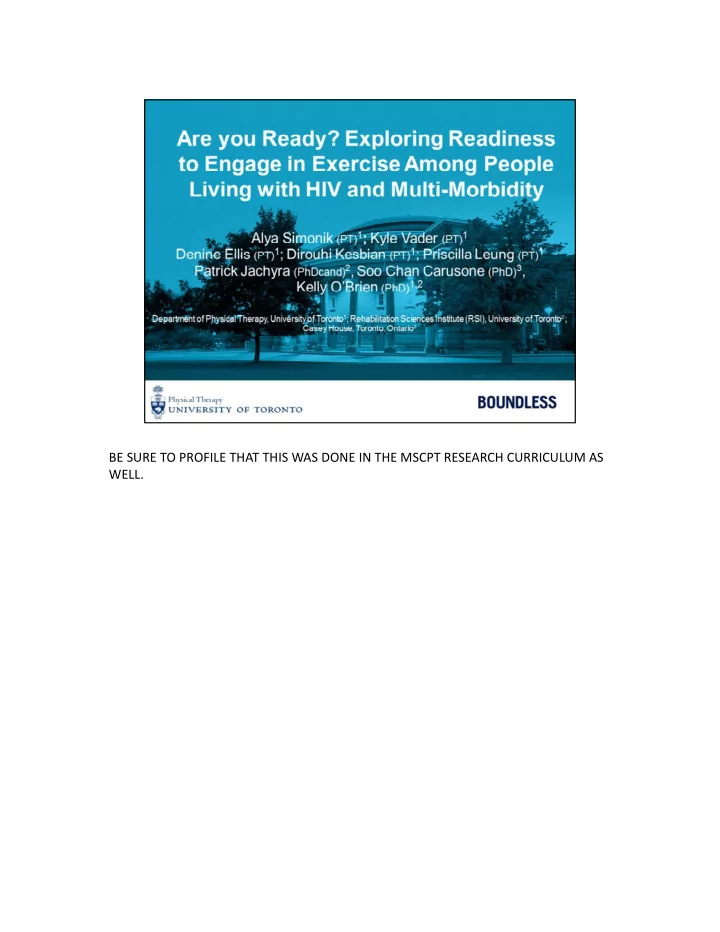

BE SURE TO PROFILE THAT THIS WAS DONE IN THE MSCPT RESEARCH CURRICULUM AS WELL.
No conflicts of interest to declare 2
‐With advancement in ART, people are living longer and developing multiple health conditions; increasingly understood as a chronic condition ‐ Increasingly important to consider self‐management approaches to chronic illness ‐‐ Exercise can be safe and beneficial for people living with HIV ‐‐ Less than half participated in the recommended amount of moderate to vigorous physical activity ‐ Essential to look beyond the physical benefits of exercise to consider the concept of readiness to engage 3
Readiness can be understood as an individual's predisposition to engage in a health behaviour change or the indication of a central motivating force . 21 approximately 40% of the sample were in the precontemplation, contemplation or preparation stages. 4
5
6
‐ Eight open‐ended questions with probes ‐ Include examples of the questions 7
8
9
10
When describing their readiness to engage in exercise, participants went on to explain the circumstances or factors that influenced their readiness From these descriptions, we were able to identify a key factor‐ the complex and episodic nature of HIV and multi‐morbidity This key factor represents the day‐to‐day challenges and uncertainty that come along with living with multiple health conditions Interestingly, this key factor did not act solely as a barrier to exercise, as we had originally anticipated. Rather, for some it acted as a hindrance to exercise (“ my body is aching and sore, my lungs are sore and it’s hard to catch a good breath, so it’d be hard to exercise because of that ”), But for others it acted as a facilitator to exercise (“ I think exercise is even more important now ‘cause I think it can be a real positive to longevity and one’s overall health’ ) 11
‐To demonstrate our findings, we developed a framework. In this image we outline the relationship between factors and the influence on readiness to engage in exercise. In addition to the key factor, participants also identified four subfactors that influenced their readiness to engage in exercise (social support, perceptions and beliefs, experience with exercise and accessibility). These subfactors affected participants to various degrees (for example, some found social support to be a particularly important); however, all the subfactors were experienced through the lens of the key factor (the complex and episodic nature of HIV and multi‐morbidity) 12
Our participants expressed a wide range of perspectives about readiness to engage in exercise, which allowed us to understand readiness as a dynamic construct that fluctuated over time based on one’s circumstances We were able to identify a key factor that influenced readiness for all participants‐ the complex and episodic nature of HIV and multi‐morbidity 13
Our participants expressed a wide range of perspectives about readiness to engage in exercise, which allowed us to understand readiness as a dynamic construct that fluctuated over time based on one’s circumstances We were able to identify a key factor that influenced readiness for all participants‐ the complex and episodic nature of HIV and multi‐morbidity Since we know that exercise is an important, effective self‐management strategy for PLWH, the findings from our study emphasize the important role that HCPs have to play in facilitating improved readiness to engage in exercise To do so, we must consider the factors that may be influencing one’s readiness, including the complex and episodic nature of HIV and multi‐morbidity, in order to make meaningful and feasible recommendations regarding exercise 14
15
16
17
18
19
Recommend
More recommend